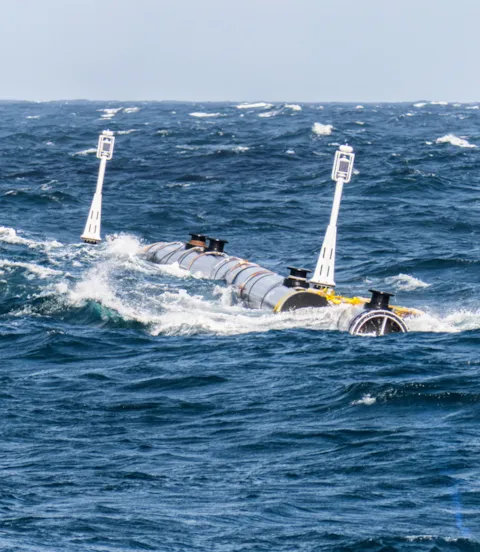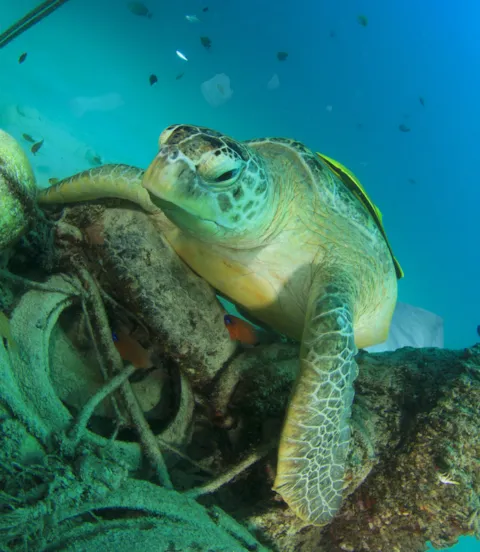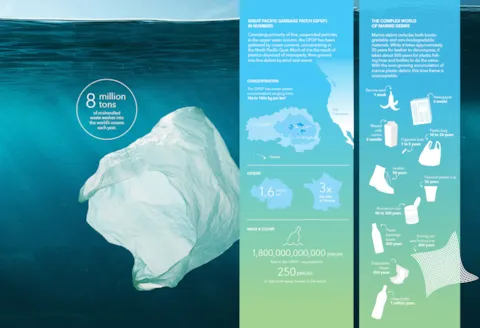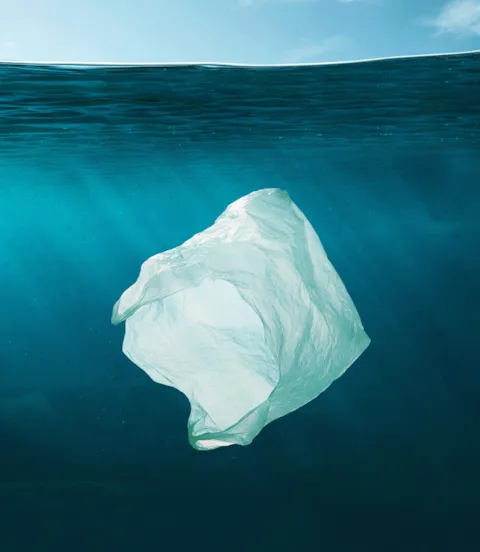Time for action on plastic pollution
Growing public awareness of marine plastic debris has put pressure on governments to act, but some in the maritime industry are already moving ahead to manage the crisis.
Plastic pollution is washing up on the shores of the Hawaiian Islands, settling onto seabeds in the Arctic Ocean, and rising through the food chain onto our dinner tables. By one estimate published by the United Nations Environment Programme (UNEP), there will be more plastic than fish in the world’s oceans by 2050 unless action is taken.
According to Arnstein Eknes, who is responsible for DNV GL’s marine plastic awareness initiatives, managing the crisis is a shared responsibility, but he believes the maritime industry has an important role to play in finding a solution. “Plastic lost in nature is the challenge. By encouraging the public to stop using single-use plastic items, we can all reduce waste,” he says. “And by leveraging different maritime technologies to remove existing waste, we can reverse the direct and indirect impacts of industrial and human activity. Proper recycling systems and good waste management solutions bringing plastic into circular economies are essential. For the maritime industry, sitting on the sidelines is not an option.”
Eknes notes that DNV GL has studied the issue and in 2013 launched Plastic Aquatic, an extraordinary innovation project in cooperation with World Wildlife Fund Norway to gain deeper insight into the extent of global marine debris. In addition to assessing the impact of marine plastic debris and microplastics in our oceans, the project recommended solutions.
“While the past decade has given a clearer understanding into how plastic debris impacts marine and coastal biodiversity, the future challenge lies in closing significant knowledge gaps within management, mitigation and debris collection technology,” says Eknes. “Plastic debris is a transboundary concern. Global collaborative action is needed to develop and deploy technology that maps, monitors and minimizes the overall environmental footprint of plastic products.”

Understanding the challenge
In 2016, the global plastics production totalled around 335 million metric tons. Each year, eight million tons of mishandled waste washes into the world’s oceans, further adding to the total ocean plastic debris aggregate, approximately 150 million tons. The end results are alarming.
For example, the Great Pacific Garbage Patch (GPGP), a floating gyre of marine debris in the central North Pacific Ocean first discovered in 1997, now holds sixteen times more plastic than previously estimated, according to a study released by an international team of scientists affiliated with The Ocean Cleanup Foundation. Three times the size of France with over 1.8 trillion pieces of plastic weighing some 80,000 metric tons, the GPGP is the largest accumulation zone for ocean plastics on earth. If left to fragment, the amount of hazardous microplastics will increase more than tenfold. Microplastics are choking oceans, strangling underwater creatures and playing havoc with aquatic systems. When scientists and researchers from New York’s Cornell University concluded a recent four-year survey of 159 reefs in Australia, Thailand, Indonesia and Myanmar, their findings were alarming. Over eleven billion microplastic particles are entangled in corals across the Asia-Pacific region causing severe damage to pristine coral reef ecosystems.
Plastics block sunlight and abrade reef-building corals, creating sores that become conduits for infection and disease that eats away at coral tissue. When corals are in contact with plastic, the likelihood of coral disease increases 20-fold, from four per cent to 89 per cent, study reports reveal. “Once coral tissue loss occurs, it’s not coming back,” says Drew Harvell, senior author of the study at Cornell University. “It’s like getting gangrene on your foot. There is nothing you can do to stop it from affecting your whole body.”
No quick fix
DNV GL sees a tremendous need to scale up research and innovation initiatives to meet the global marine plastics challenge. And despite the world’s oceans filling up with more and more plastic waste and microplastics, Eknes is optimistic. He sees growing international awareness, a greater interest to create solutions, and a global desire to collaborate. “While there seems to be slow progress towards short and long-term approaches to solve the ocean plastics problem, there are many global initiatives bubbling under the surface,” he explains, pointing to recent initiatives launched by IMO and the European Commission.
Last year when IMO placed marine plastics on its high-level Marine Environment Protection agenda, it sent the 150 MARPOL Annex V countries a clear message: The industry must do more to fight against plastic pollution. “IMO legislation has and will continue to play a leading role in shipping’s responsibility to minimize the entry of destructive marine plastics into our oceans,” says Eknes.
Ramping up its quest for healthier oceans and the protection of global marine ecosystems, in May 2018 European Commission proposed new EU-wide rules to target the ten single-use plastic products most often found on Europe’s beaches and seas, as well as lost and abandoned fishing gear. Together, these constitute 70 per cent of all marine litter items.
The UN Environment’s #CleanSeas campaign, launched in February 2017, has significantly raised global awareness of what plastic waste is doing to our oceans. Since its launch, 50 governments – accounting for more than half the world’s coastline – have signed up to the #CleanSeas campaign, with many making specific commitments to protect oceans, encourage recycling and cut back on single-use plastics.

Leveraging maritime technology
So, what can the industry do to mitigate the plastic debris crisis? “First, as individuals, we should be aware of everyday plastic choices – just use less plastic,” says Eknes. “Second, we need better technology to remove and keep plastics out of the oceans. Fortunately there are some exciting developments within the industry that can be used to collect plastics and microplastics before and after they have reached the oceans.”
One such development has been spearheaded by Boyan Slat, a Dutch inventor and founder of The Ocean Cleanup, who intends to clean up half the Great Pacific Garbage Patch in five years’ time with the world’s first ocean plastic-cleaning machine. The one-kilometre V-shaped boom moves naturally with the waves, scooping and channelling floating plastics towards the centre of the V for monthly collection and recycling. Slat, the 2017 winner of the Heyerdahl Award for exceptional technical innovation and environmental work, has raised over 31 million US dollars to develop the technology, which is currently being tested 50 nautical miles outside of San Francisco’s Golden Gate Strait.

In 2013, DNV GL in cooperation with WWF Norway introduced a concept for a specialized research and marine debris collection vessel (Spindrift). Elements of this concept vessel will be included in the Research Exploration Vessel (REV), as part of the REV Ocean project, now being developed by Norwegian entrepreneur Kjell Inge Røkke and former WWF leader Nina Jensen. WWF Norway is a partner in the project. When completed in 2020, the REV will be the largest research and expedition vessel in the world.
The REV will be equipped with state-of-the-art marine surveying equipment, laboratories, auditorium, classrooms, two helipads and an underwater ROV. The ship’s mission control room will monitor satellite images of eddies and convergence
fronts on the ocean surface and deploy UAV’s and helicopters to detect marine plastic debris. In addition to being a platform for developing and testing microplastic removal technology, the ship will also have the capacity to convert tons of end-oflife plastics into on-board heat and power energy through specialized collection and sustainable waste incineration processes.

Seismic technology
Another promising development is the use of seismic technology to identify and remove marine plastics. PGS, which operates a fleet of specialized seismic vessels for the oil industry, has developed a large-scale concept for plastic collection at sea. Its system releases massive amounts of bubbles at depths of 50 metres which push microplastics upwards into the booms towed by the support vessel. Here, a processing unit removes organic materials before compressing, packaging and sending the plastic debris to process facilities for recycling.
“There’s no limit to innovation,” says Eknes. “Instead of cold-stacking offshore vessels during low market cycles, the owners could use their high propulsion power and large towing spread capability for global plastic collection. The key challenge is of course the associated cost.”


Greater collaboration: global action
While encouraged by these developments, Eknes believes more can be done. “As an industry, we can achieve more by developing a structured approach for increased collaboration between various industry stakeholders,” he says. “The collaboration between NGOs, governments and private businesses will be critical to achieve more effective solutions for the recapture, recovery and reuse of marine plastic. Without global collaboration, we will be unable to fully identify and craft a suite of globally relevant marine debris solutions that make sense for business and the oceans.”
Meanwhile, the rise of localized marine debris networks, such as the Indonesian Waste Platform, the African Marine Waste Network, the Portuguese Marine Litter Association, the Australian Marine Debris Initiative and the German Round Table Against Marine Litter, are bringing hundreds of stakeholders together. “The impact of hub-connecting networks and collaborations across the globe will create major long-term improvements for greater upstream focus and waste management initiatives,” says Eknes.

Looking ahead
What is the perfect five-year plastics scenario? According to Eknes, it would include prototype collection technologies in the largest 20 rivers of the world, novel innovative management systems for land-based plastic waste treatment, disposal and recycling, the ability to remotely detect and monitor marine debris at par with that of oil spills, and the growth of a circular plastics economy.
“We need a broader rethink and a new approach to capturing value in a new plastics economy. While waiting for industrialized countries to take immediate action by reducing waste and curbing the growth of single-use plastic, we need to extract the maximum value from its use, then recover and regenerate products and materials at the end of their service life,” says Eknes.
“At DNV GL, safeguarding the environment is close to our hearts,” he adds. “We are passionate about contributing to smart and better decisions. The world needs solutions, guidance and improved future outlooks. We want to take part in building a road map to help the world tackle the marine debris challenge.”
